Download the "Cloud Knowledge Discovery on KDD Papers" whitepaper to explore 12 KDD papers and knowledge discovery from 12 Alibaba experts.
By Yukuo Cen, Jianwei Zhang, Xu Zou, Chang Zhou, Hongxia Yang, Jie Tang
This paper, Controllable Multi-Interest Framework for Recommendation has been accepted by KDD 2020.
Recently, neural networks have been widely used in e-commerce recommender systems. A neural network-based recommendation algorithm usually only learns one user representation vector from the user's behavior sequence. In most cases, this unified representation vector cannot reflect the user's different interests over a period of time. As shown in the following figure, Emma's click sequence reflects her recent three different interests: jewelry, handbags, and make-up. We propose a controllable multi-interest framework, ComiRec, for recommendation, which is used to recommend items based on a user's click sequence. The multi-interest extraction module captures a user's various interests from this user's click sequence. These interests can be used to recall similar items. The aggregation module aggregates the recalled items into a list of candidate items for recommendation, which will be used by downstream tasks.
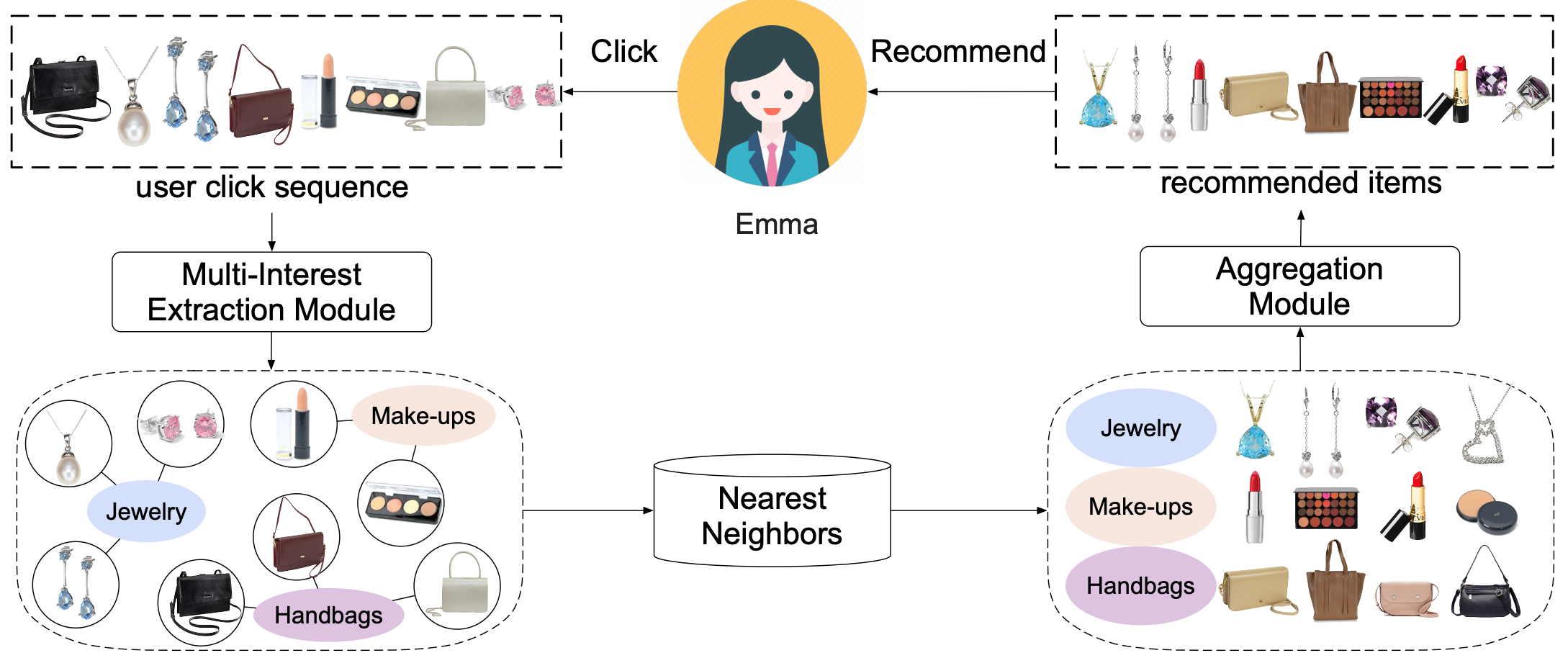
We designed the multi-interest extraction module with reference to the existing work on multi-interest networks with dynamic routing (MIND) [1]. The MIND model extracts a user's multiple interests by using the algorithm of dynamic routing between capsule networks [2]. To implement the multi-interest extraction module, we explored the dynamic routing algorithm and a self-attention-based approach. Further studies are required to determine the optimal choice to implement this module. The multi-interest extraction module is trained by predicting a user's next clicks based on this user's historical click sequence. Specifically, for a sample pair (u,i) in a training set, we can acquire user u's multiple representations v_1,v_2,…,v_K by analyzing this user's click sequence before this user clicks item i. Then, we select the user representation v_t that is closest to the representation e_i of item i. The following negative log-likelihood function is optimized:

where I is an aggregation of items. The summation formula in the denominator place results in excessive calculation overhead. Therefore, we use a sampling-based softmax technique for approximate calculation. After training, the multi-interest extraction module can learn multiple representations of the user from the user's historical click sequence. The following figure shows the training process of the module.
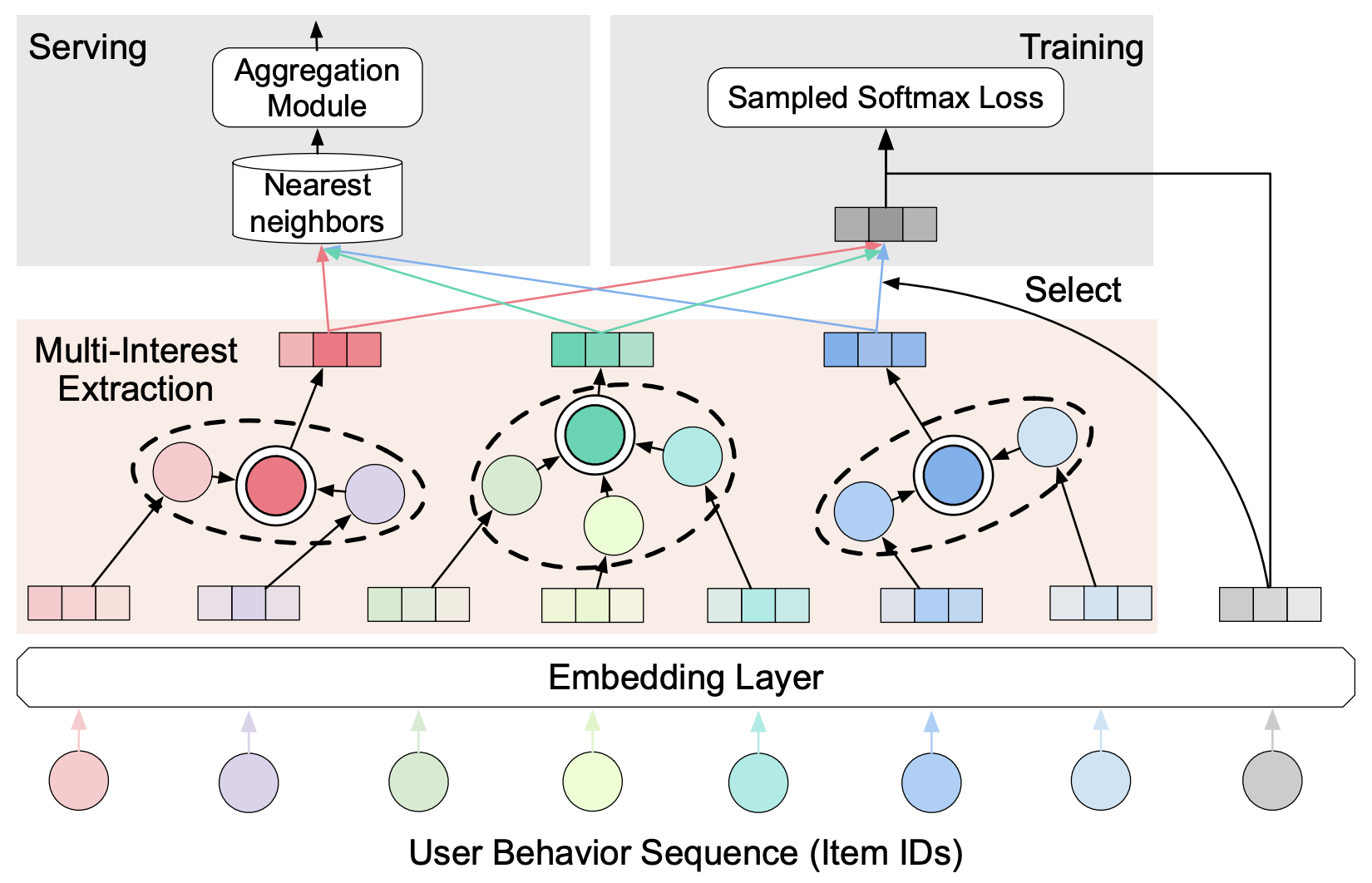
To verify the effectiveness of the multi-interest extraction module, we conducted experiments on two public datasets from Amazon and Taobao. According to the statistics listed in the following table, our ComiRec-SA/DR approach achieves the optimal effect on the basis of both datasets. SA indicates the self-attention method and DR indicates the dynamic routing method.

We conducted a case study based on an actual user's interests. The multi-interest extraction module learns four recent interests of the user from the user's historical click sequence, including sweets, gift boxes, phone cases, and accessories. As shown in the following figure, the left part lists the user-clicked items, and the right part lists some of the items that are recalled from a large item pool based on the user's interest representations.
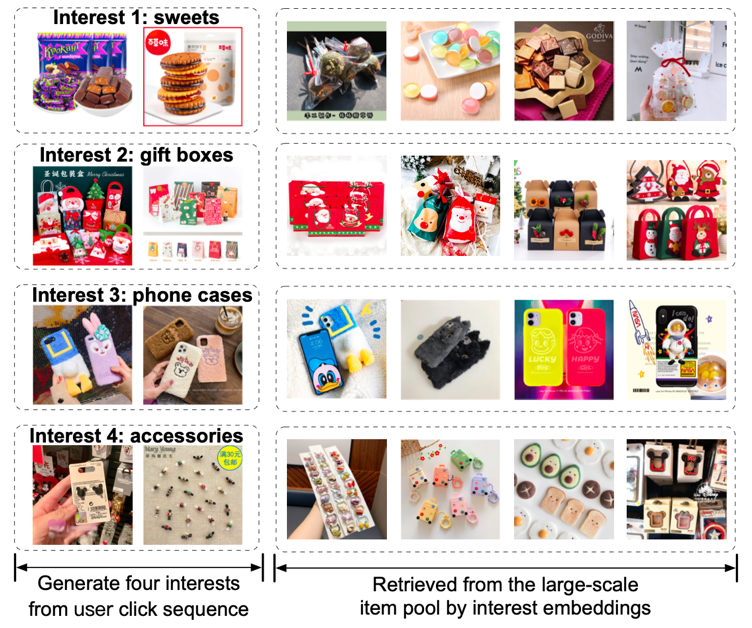
It is important to figure out a way to enable downstream tasks to use these multi-interest representations. To this end, we propose the controllable aggregation module. Given a user's multi-interest representations v_1,v_2,…,v_K, the most direct approach to analyze them is to define the item-user similarity as a score of the interest representation that is most relevant to the items, that is,  . This approach can maximize the recommendation accuracy but does not make full use of multi-interest representations. The controllable aggregation module can adjust the accuracy and diversity of recommendations based on multi-interest representations. We define the following value function that shows the relationship between user u and item set S:
. This approach can maximize the recommendation accuracy but does not make full use of multi-interest representations. The controllable aggregation module can adjust the accuracy and diversity of recommendations based on multi-interest representations. We define the following value function that shows the relationship between user u and item set S:

where g(i,j) denotes the difference between items i and j, for example, g(i,j)=δ(CATE(i)≠CATE(j)). CATE(i) denotes the category of item i. δ(⋅) is an indicator function. We selected an item set S from the items that were recalled based on interest representations. This maximized the value function Q(u,S), allowing us to acquire a set of recommended items. We can use a greedy strategy to acquire a better solution for this function. The approximation algorithm is as follows:
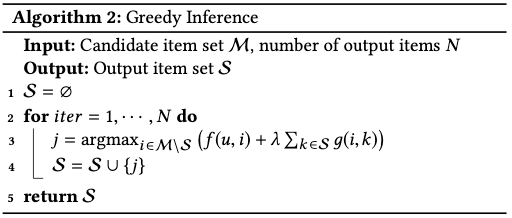
In hyperparameter settings, if you want to maximize recommendation accuracy, set λ=0. This has the same effect as the most direct approach mentioned above. With λ=+∞, the aggregation module finds the most diverse item set. We tested the controllable aggregation module on a dataset from Amazon. As the factor λ increases, the recall metric for recommendation slightly decreases, but the diversity of recommended items significantly increases. Increasing the diversity of recommended items can improve user experience to a certain extent.
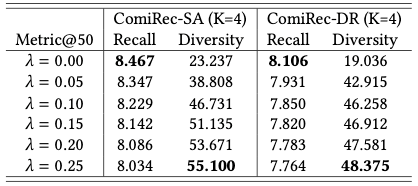
[1] Li, Chao, et al. "Multi-interest network with dynamic routing for recommendation at Tmall." Proceedings of the 28th ACM International Conference on Information and Knowledge Management. 2019.
[2] Sabour, Sara, Nicholas Frosst, and Geoffrey E. Hinton. "Dynamic routing between capsules." Advances in neural information processing systems. 2017.
The views expressed herein are for reference only and don't necessarily represent the official views of Alibaba Cloud.
Understanding Negative Sampling in Graph Representation Learning

2,593 posts | 791 followers
FollowKaiwai - September 9, 2019
Alibaba Cloud MaxCompute - February 28, 2020
ApsaraDB - June 29, 2020
Alibaba Clouder - January 21, 2020
Alibaba Clouder - September 2, 2020
Alibaba Clouder - May 11, 2020

2,593 posts | 791 followers
Follow Platform For AI
Platform For AI
A platform that provides enterprise-level data modeling services based on machine learning algorithms to quickly meet your needs for data-driven operations.
Learn More Epidemic Prediction Solution
Epidemic Prediction Solution
This technology can be used to predict the spread of COVID-19 and help decision makers evaluate the impact of various prevention and control measures on the development of the epidemic.
Learn More Personalized Content Recommendation Solution
Personalized Content Recommendation Solution
Help media companies build a discovery service for their customers to find the most appropriate content.
Learn More AIRec
AIRec
A high-quality personalized recommendation service for your applications.
Learn MoreMore Posts by Alibaba Clouder